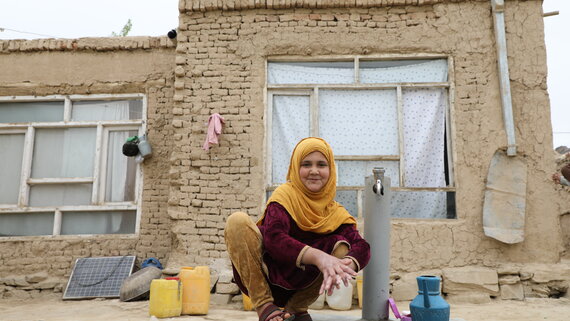CERF and the CBPFs continue to ensure that life-saving assistance reaches people caught up in crises. The funds are central to humanitarian efforts, providing coherent and timely responses and support to in-field coordination, and reinforcing the leadership of Humanitarian Coordinators (HCs).
Thanks to donors’ strong support, both funding vehicles were instrumental in ensuring life-saving humanitarian assistance in 2022. The funds allocated a total of $1.7 billion to assist people most in need, and as of November 2022, they are on track to match their highest annual allocation level ever: $1.76 billion.

Hewad Mena, Maidan Wardak Province, Afghanistan
Zahra, 10, washes her hands at a new water tap near her home. “I used to walk one hour to bring water, and I had to stand in the queue for one or two hours,” she said. With CERF funding, UNICEF completed a solar-powered water supply network for this settlement of displaced Afghans, providing 24-hour access to clean water for more than 500 families and 3,800 people.
UNICEF/SherzaiCERF had allocated close to $612 million as of November 2022, already the second-highest annual amount in its history. This funding enabled the UN and partners to provide life-saving assistance to approximately 28.2 million people affected by conflict, climate change, natural disasters and disease outbreaks in 41 countries worldwide. Funding enabled immediate responses to new and deteriorating crises. Underfunded emergencies received a total of $160 million in 2022.
The CBPFs have allocated $1.11 billion to provide life-saving support for 54.4 million people, as of November 2022. This already surpasses the previous record year 2021, when $1.03 billion were allocated. The Afghanistan and Ukraine Humanitarian Funds provided $283 million and $188 million respectively, in response to rapidly evolving needs.
As the gap between humanitarian needs and available resources continues to grow, innovative approaches to ensuring efficient and effective humanitarian action are more important than ever. In 2023, the pooled funds will continue to work towards driving system change and enhancing the quality of humanitarian programming. Among other things, OCHA will focus on the strategic impact of funding allocations, supporting a more accountable humanitarian response, making earlier allocations, and supporting anticipatory and early action approaches.
Pooled funds allocations in US$ (November 2022)
Adaptability and complementarity
OCHA’s pooled funds continue to demonstrate their effectiveness and responsiveness through their ability to expand and contract, adapting as a crisis evolves. Further, when CBPF and CERF resources are provided in the same contexts, the HCs at country level ensure those resources are used in a complementary manner, engaging the comparative advantages of each funding mechanism. To ensure complementarity and to maximize comparative advantages, HCs look at one or several principles to underpin CBPF-CERF allocation strategies:
- Temporal sequencing: Selecting a fund to support a different phase(s) of response.
- Complementary recipients: Funding different recipient organizations to maximize coverage and best address the overall situation.
- Complementary sectoral focus: Funding needs in different sectors to achieve desired programmatic coverage.
- Complementary geographic targeting: To achieve the desired spatial coverage and meet the needs of the most affected communities.
- Common global priorities and cross-cutting issues: CERF and CBPF allocations can reinforce consideration of and allocations to key themes.
Top contributions to Pooled Funds (November 2022)
The funds’ complementarity and adaptability were vividly illustrated in Ukraine by the combination of CERF’s speed and the CBPFs’ capability to rapidly scale up capacities and partnerships. On 24 February 2022, CERF allocated $20 million for Ukraine through its Rapid Response window, followed on 14 March by another $40 million as the crisis escalated. These funds supported emergency operations along the contact line in the eastern oblasts of Donetsk and Luhansk and in other areas of the country. Health care, shelter, food, water and sanitation were provided to the most vulnerable people, including women and girls, the elderly and the displaced. The allocations enabled UN agencies and partners to reach 950,000 people (304,000 women, 456,000 men and 190,000 children), including 114,400 people with disabilities.
In parallel, the Ukraine Humanitarian Fund (UHF) quickly re-set its operations, expanding the fund management team, introducing tailored procedures for fast-tracking new partners, and sending funds quickly to partners across conflict lines. In a short time span, the UHF allocated initial donor contributions of some $118 million to address prioritized needs, an increase from $14 million in 2021. The funding complemented CERF support, providing multisectoral assistance to displaced and non-displaced people, protecting civilians, and supporting basic services for up to 5 million people.
In contrast, two downsizing operations demonstrate the funds’ adaptability to contract in a way that reflects the shifting context. Following several years of declining humanitarian needs and donor contributions, it was decided to wind down the CBPFs in Jordan and Iraq. Closure is expected to be completed in 2023 with the finalization of implementation, oversight of projects and reporting commitments. Lessons learned through stakeholder consultations will continue to inform operations and best practices in other contexts.

